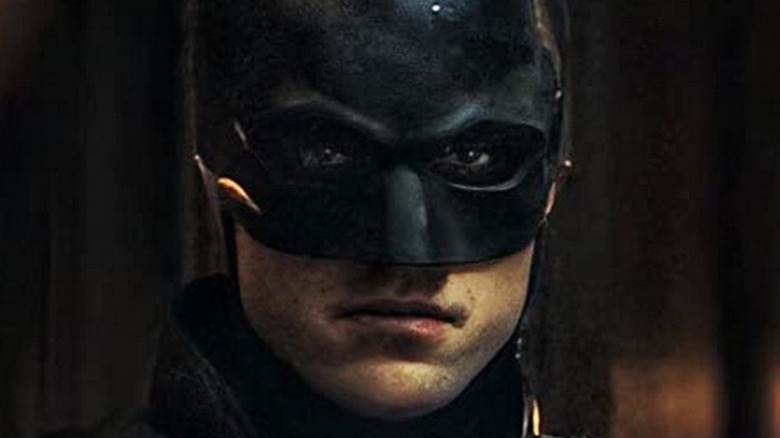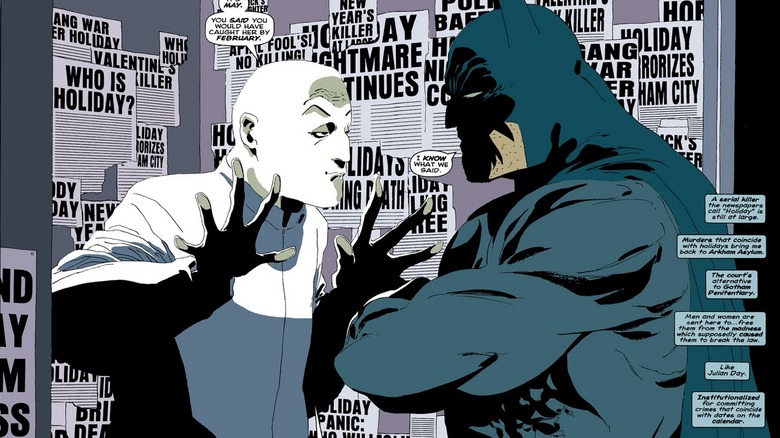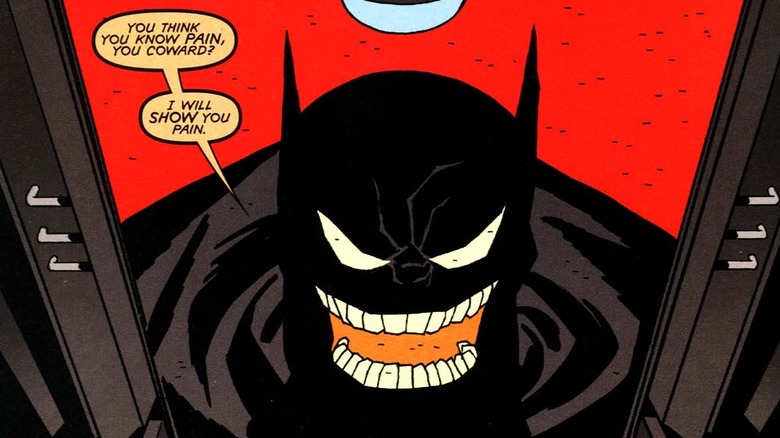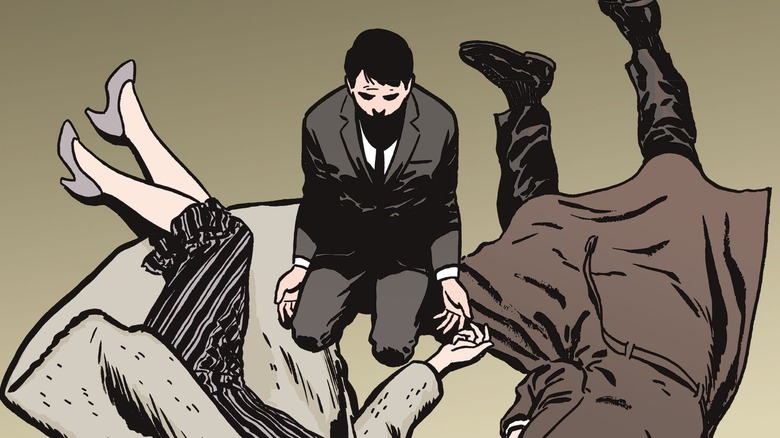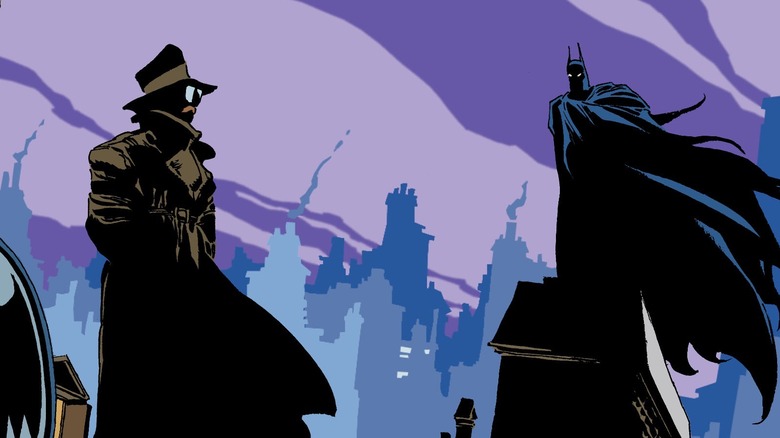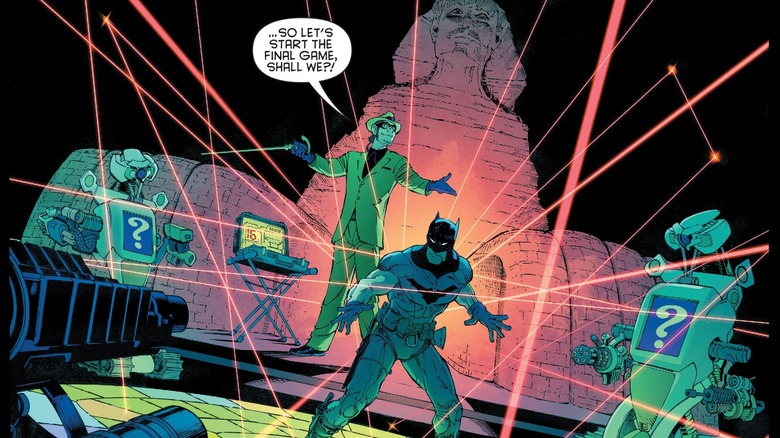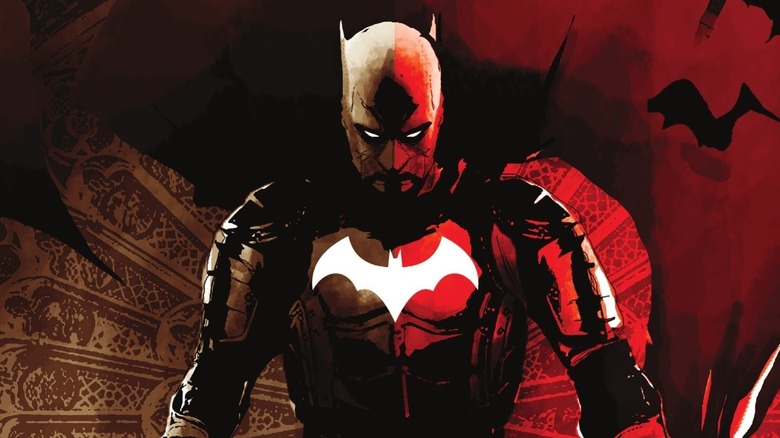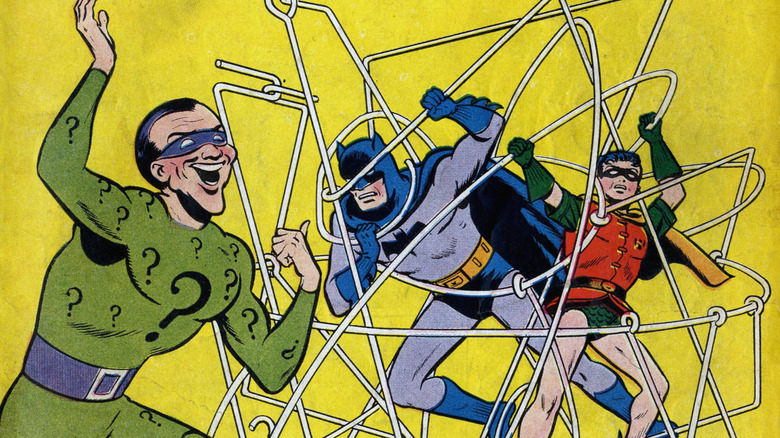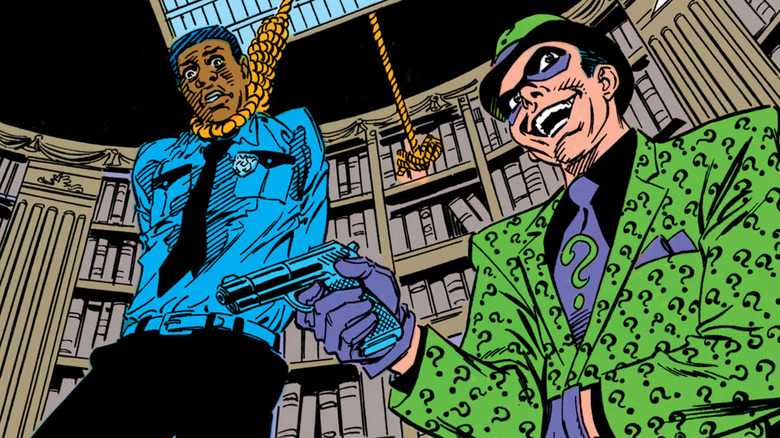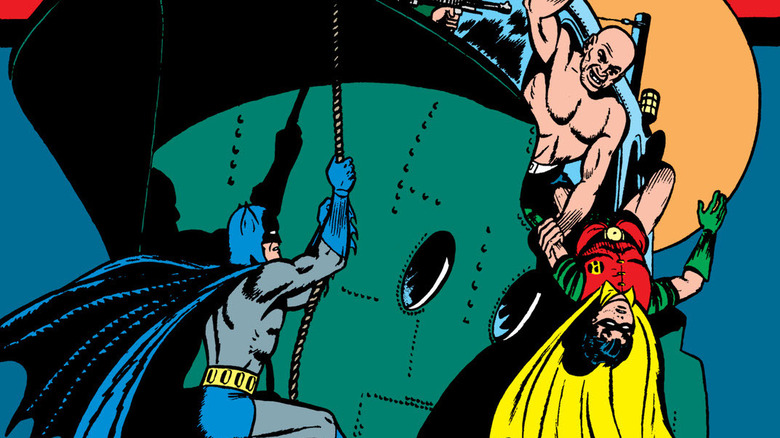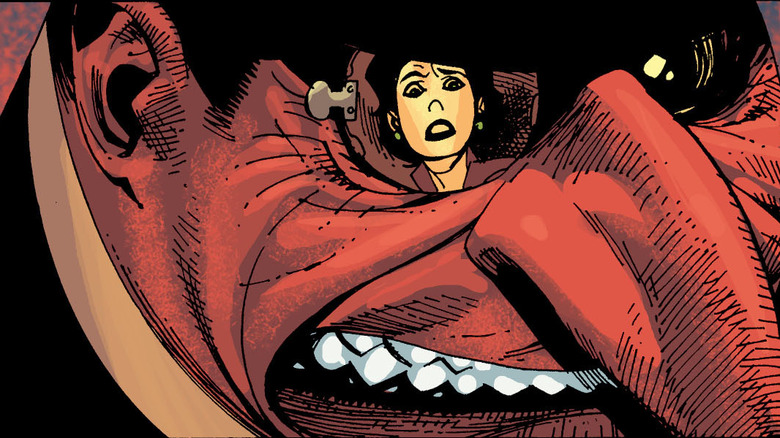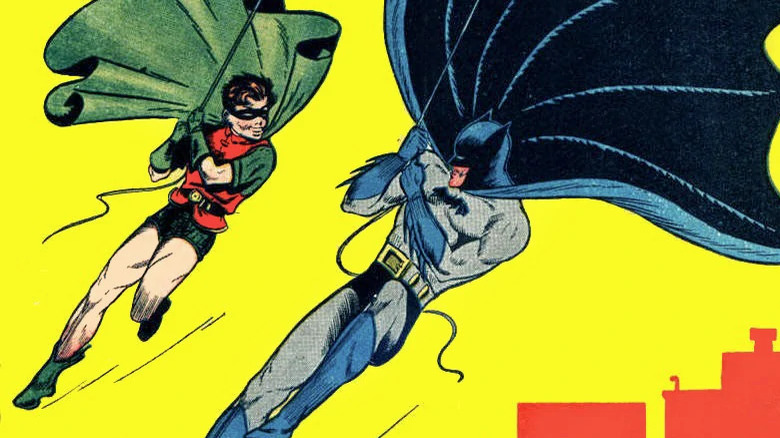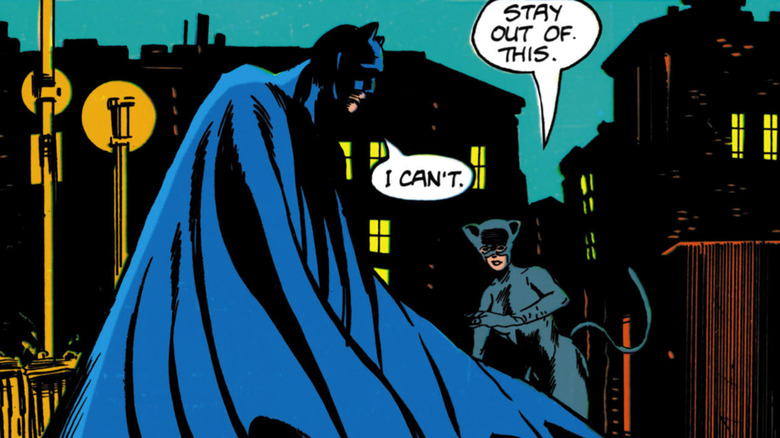12 Classic Batman Comics To Read Before You See The Batman
Matt Reeves' upcoming superhero flick "The Batman" might just become the Dark Knight's finest on-screen adventure. Ever since that first teaser trailer was released at 2020's DC FanDome event, fans have been eagerly awaiting the chance to explore Gotham City and meet the latest iteration of its watchful protector — and from the movie's stellar cast to its grim and gothic vibe, as well as the intriguing prospect of a whole shared universe springing from its story, there's clearly a lot to love about this latest Bat-movie.
Of course, a Batman movie is nothing without its comic book influences. For example, Zack Snyder told CBR in 2015 that "Batman v Superman: Dawn of Justice" drew heavily from Frank Miller's iconic 1986 arc "The Dark Knight Returns," while Christopher Nolan told a Q&A audience in 2008 that the portrayal of the Joker in "The Dark Knight" was influenced by Alan Moore's equally groundbreaking 1988 comic "The Killing Joke." Nolan has also cited (via Polygon) such comics as "The Long Halloween" as inspiration for the second movie in his Batman trilogy.
So, which comic books have been plundered by Matt Reeves and company for the latest installment in Batman's cinematic canon? And which classic storylines are must-reads for any fan who wants to prepare themselves for Reeves' film? Straight from the grisly streets of Gotham City, here are 12 classic Batman comics to read before you see "The Batman."
Batman: The Long Halloween
In August 2021, DC announced (via ComicBook.com) the release of "The Batman Box Set," a collection of softcover editions of the three comic books that influenced Reeves during production on "The Batman." The first of these stories is Jeph Loeb and Tim Sale's superb 13-part series, "Batman: The Long Halloween."
Published in 1996 and 1997, "The Long Halloween" takes place early in Bruce Wayne's crime-fighting career. At the beginning of this series, Batman is still learning the ropes, Gotham's villains are as powerful as ever, and the city's two mob families are on the verge of war. Things only go from bad to worse when a new serial killer begins bumping off gangsters, with each murder taking place on a different seasonal holiday. Naturally, it falls to Batman to track down the killer and save the city.
It's not hard to see the impact of "The Long Halloween" on "The Batman." The basic premise — that of Bruce Wayne hunting a serial killer who is targeting Gotham's most powerful players — is more or less identical, for one. We also know that Carmine Falcone, a key character in the comic book, is involved in "The Batman," where he's played by John Turturro. Moreover, Jeffrey Wright revealed on his Instagram in 2020 that he was reading "The Long Halloween" to prepare for his role as Jim Gordon in the movie. Nobody can know just how much Reeves has drawn from "The Long Halloween" until "The Batman" is actually released, but it certainly seems to have played a significant role in the movie's development.
Batman: Ego
The second comic book included in "The Batman Box Set" is "Batman: Ego and Other Tails." While this compilation contains a handful of stories, it's "Ego" that you'll want to read to gear yourself up for "The Batman." At 2020's DC FanDome event (via Animated Times), Matt Reeves elaborated on the comic books that had helped him prepare for "The Batman." In an interview with Aisha Tyler, he said, "For me I think one of the cool deep dive ones was Darwyn Cooke's 'Ego.' He's confronting the beast that is Batman and there's a kind of duality ... The degree to which you have self-knowledge, you're able to understand your motivations, but ... he's broken, Batman."
Published in 2000, "Ego" begins with Batman chasing down one of the Joker's thugs, who has recently given up information to the Caped Crusader. When the henchman takes his own life in order to escape Joker's wrath, a traumatized Batman is forced to reckon with his own guilt and rage. To reveal more would spoil an excellent story, but "Ego" yields an enthralling and surprisingly literal deep-dive into Batman's psyche.
In November 2021, Warner Bros. released a synopsis for "The Batman" that described Robert Pattinson's version of the character as "a disillusioned, desperate vigilante awakened by the realization that the anger consuming him makes him no better than the ruthless serial killer he's hunting." Evidently, this movie will also attempt to explore the darkest corners of Bruce Wayne's mind — and if it manages this even half as successfully as "Ego," we're sure to be in for a treat.
Batman: Year One
The final story included in "The Batman Box Set" is also one of the most beloved Batman stories of all time: 1987's "Batman: Year One." Written by Frank Miller and illustrated by David Mazzucchelli, "Year One" is arguably the seminal origin tale for the World's Greatest Detective.
"Year One" follows a young Bruce Wayne as he returns to Gotham City after a long absence, adopts the Batman alter-ego, and takes the fight to Gotham's underworld. Back in 2004, "Batman Begins" writer David S. Goyer told CBR that the comic had at least partially inspired Christopher Nolan's first Batman movie, "Batman Begins." From Bruce's training to Gotham's aesthetic to the looming presence of the city's crime families, that inspiration is practically palpable on the screen.
In February 2020, Reeves hinted towards a "Year One" connection on his own project when he posted a panel from the story on Twitter. Previously, Reeves had told Collider that "The Batman" was not a straight-up adaptation of "Year One," but did admit that it's "one of the many comic books that [he loves.]" Indeed, a number of aspects from the plot appear to be present in "The Batman," including a focus on police corruption, the portrayal of a younger, less experienced Bruce Wayne, and the mysterious involvement of Selina Kyle. While Reeves may not be fully adapting "Year One," it's not hard to imagine that he has been heavily inspired by this hugely influential Batman tale.
Batman: Dark Victory
Back in 2018, a Twitter fan asked Matt Reeves to name his favorite Batman comic. His reply featured a handful of titles, most of which you'll recognize, including "Year One," "The Long Halloween," and "Ego." But he also mentioned another comic: "Batman: Dark Victory."
Debuting in 1999 and created by the dynamic duo of Jeph Loeb and Tim Sale, "Dark Victory" is a direct sequel to "The Long Halloween." The story begins with a mass breakout from Arkham Asylum, setting a mysterious killer known as the Hangman loose on Gotham. As he investigates this new threat, Batman is forced to tackle the Holiday Killer's legacy, deal with more mob politics, and train a new partner-in-vigilantism: Dick Grayson. As IGN's 2005 review puts it, "['Dark Victory'] uses the events of the original to further explore the psychological makeup of the Dark Knight ... [adding] new context to the Batman we all know and love."
Along with "The Long Halloween," "Dark Victory" was once named in an interview with UGO as Christian Bale's favorite Batman comic, and it appears that Matt Reeves is just as much a fan of Loeb and Sale's follow-up. How this might translate to "The Batman," however, remains to be seen — while it doesn't seem likely that Reeves' movie will feature Robin's introduction or Two-Face's brutal rampage across Gotham, you never know what a sequel might bring.
Batman: Zero Year
In 2011, the entire DC Comics continuity was reset, rebooted, and relaunched into the New 52: a line of 52 new comic book series that established a new universe for the company's most famous heroes.
Batman's reimagined origin was told in the crossover event "Batman: Zero Year," which was published throughout 2013 and 2014. This is a tale made up of three separate arcs: "Secret City" follows a young Bruce Wayne as he returns to Gotham City and encounters the city's many supervillains; "Dark City" sees the newly-christened Batman teaming up with Jim Gordon to hunt down Doctor Death and the Riddler; while "Savage City" brings the tale to a close as Batman attempts to wrest control of Gotham from the Prince of Puzzles. "Zero Year" was met with widespread critical acclaim upon its release, with ComicsAlliance writing that while "it might never replace 'Year One,' ['Zero Year'] more than lives up to that legacy."
"The Batman" has clearly taken a leaf out of the "Zero Year" comic. They both feature the Riddler as the main antagonist — but eagle-eyed fans may have spotted another intriguing connection between these two stories. One of the most significant turning points in "Zero Year" comes when the Riddler floods Gotham, plunging the city into total chaos. A handful of shots from the trailers for "The Batman" suggest something similar might happen in the movie. What other attributes could Reeves have lifted from "Zero Year" for his project? Only time will tell.
Batman: The Imposter
"Batman: The Imposter" is a limited series published from early 2021 to the beginning of 2022. "The Imposter" finds Bruce Wayne in his second year as the Caped Crusader and dealing with an unexpected threat: a copycat vigilante who has begun murdering Gotham's criminals. As the city begins to turn on him, Batman must find and defeat the monster that is defiling his name. In its glowing review of "The Imposter," DC Comics News reported that the series takes place in "a wholly new version of Gotham City, informed by grim reality, where every punch leaves a broken bone and every action has consequences far, far beyond Batman's imagination!"
"The Imposter" was written by Mattson Tomlin, a screenwriter who, back in 2019, was hired to co-write "The Batman" with Matt Reeves and fellow screenwriter Peter Craig. In a 2020 interview with Insider, Tomlin revealed more about working with Reeves in particular, telling the publication, "We were in the same room at a desk together for many months and just going through the process — I'd never written with anyone before — and co-writing it with him, I really do think he's one of our great filmmakers." Since "The Batman" was written first, "The Imposter" can't really have been an influence per se, but it will no doubt be fascinating to find out how much of the comic book exists in the movie — and vice versa.
Detective Comics #140
You're probably aware by now that the lead villain in "The Batman" is one of the character's most infamous enemies: the Riddler. Portrayed in the movie by Paul Dano, this Riddler is a Zodiac-like serial killer running amok in Gotham City, leaving a trail of curious clues that are seemingly targeted at Batman. An official press image from the movie (via Nerdist) has also confirmed that the Riddler's costume — a green combat jacket and leather mask — is suitably unnerving for this new iteration of the character.
Go back to the beginning, however, and you'll discover a very different kind of Riddler. Edward Nigma was introduced to DC Comics in 1948's "Detective Comics" Vol. 1 #140. The Riddler is an expert puzzler and carnival conman who decides to take on Batman in a battle of wits, leading him through a string of deadly, puzzle-themed traps. The Riddler of this era is exactly what you'd expect from a '40s comic book, too: he's silly, colorful, and way too theatrical for his own good.
Although you probably shouldn't expect to see Paul Dano's Riddler rigging a gigantic cob of corn to crash into a crowd of innocent bystanders, it's always worth revisiting a villain's true origins before you meet them on the big screen — if for no other reason than to understand how much times have changed.
Batman: Dark Knight, Dark City
If times have changed for the Riddler, "Batman: Dark Knight, Dark City" is the comic that changed them. Created by Peter Milligan and Kieron Dwyer, this 1990 arc ran through "Batman" Vol. 1 #452-454.
"Dark Knight, Dark City" finds the Riddler stumbling across evidence of an ancient demonic ritual and deciding to recreate it by using Batman as a sacrifice. In order to enact the ritual, however, the intended victim is supposed to kiss the lips of a hanged man, bathe in human blood, dance with the dead, kill a wild dog, cut the throat of an unbaptized child, and dance the sabbath before the devil. Undeterred, the Riddler sets out to trick the Bat into performing these tasks.
The Riddler of "Dark Knight, Dark City" is a far cry from the mischievous scamp of the early "Batman" comics. These two issues remade the character in a grittier mold, setting the stage for the darker, scarier villain with whom many comic book fans are so familiar. Once a relative lightweight among the hyper-violent miscreants in Batman's rogues gallery, the Riddler suddenly becomes a man who executes security guards with glee, kidnaps babies from hospitals, and creates armies of zombie robots garbed in the rotting flesh of the dead. "Detective Comics" #140 might have introduced the world to the Riddler, but "Dark Knight, Dark City" turned him into the kind of monster you'll meet in "The Batman."
Detective Comics #58
Of course, the Riddler isn't the only villain set to battle the Dark Knight in "The Batman." Played by Colin Farrell, Oswald Cobblepot will act as a secondary antagonist in the movie — and although he appears to have performed the role from underneath enough prosthetics to smother an elephant, it's clear that this version of the Penguin is more of a hard-boiled gangster than, say, the gargling aberration played by Danny DeVito in "Batman Returns."
The Penguin made his comic book debut in 1941's "Detective Comics" Vol. 1 #58. A new crook on the scene in Gotham's underworld, Oswald Cobblepot steals a painting for his unnamed "Boss" before assassinating him and taking over his gang. After framing the Caped Crusader for the theft of a jade idol, the Penguin is found and defeated by both Batman and Robin ... before making his getaway in the nick of time.
Colin Farrell's Penguin is one of the most intriguing aspects of "The Batman," if only because nobody really knows what kind of role he'll play in the movie's plot. But considering that Variety confirmed in December 2021 that Farrell will be reprising the role in his own HBO Max series, it's clear that Warner Bros. knows it's got something special on its hands. So why not go back to where it all began?
Joker's Asylum: Penguin
The "Joker's Asylum" event ran from 2008 to 2010 and consisted of a series of one-shot comics, each one following a different Gotham villain — as told by the Joker. One of the earliest of these issues was 2008's "Joker's Asylum: Penguin."
This comic book recounts the Penguin's origin, from his tormented youth to his rise to power, anchored by a grotesque "love" story between Cobblepot and a woman named Violet who he has recently rescued from slavery. Unfortunately, their budding relationship sours when Violet discovers that Cobblepot has been tracking down and destroying everybody who ever laughed at him. Same old Penguin, basically.
"Joker's Asylum" is arguably one of the stories that best captures the Penguin's character. Here, he's shown to be a damaged, pathetic man, twisted by his insecurities and the laughter of the world around him, but more than happy to fight back with death and destruction. "The Batman" probably won't have time to delve so deeply into Cobblepot's inner workings, of course, although the HBO Max series certainly will provide ample opportunity to do so. For now, we can only hope that the movie and the show portray him in as effective and disturbing a manner as "Joker's Asylum."
Batman #1
Selina Kyle, aka Catwoman, is the third foe to face the Bat in "The Batman." Portrayed by Zoë Kravitz, the movie's version of Catwoman seems to play a similar role to that of the "Long Halloween" and "Dark Victory" version of the character: a tenuous ally and foil to the Dark Knight who is nevertheless pursuing her own mysterious motives — and who will happily throw down with him if he tries to stop her.
Catwoman first appeared all the way back in 1940, in "Batman" Vol. 1 #1. In one of the later stories featured in this comic book, Bruce Wayne and Dick Grayson attend a yacht party in order to prevent the theft of an emerald necklace. After a brief dalliance with a boatful of mobsters, Batman and Robin uncover the thief: a young girl who calls herself "the Cat." She tries to tempt Batman into teaming with her as the "King of Crime," but Bats refuses, insisting that she must be taken to the police. At the last second, however, the Cat escapes — and Batman, surprisingly infatuated with his new enemy, doesn't attempt to stop her.
"Batman" #1 is a brief and unglamorous introduction to the Cat, who wouldn't be given her more famous name until the next issue. Nevertheless, this origin story is a vital piece of Batman history and an unmissable tale for any fan of Selina Kyle.
Catwoman: Her Sister's Keeper
If "Year One" is the definitive origin for Batman, "Her Sister's Keeper" is the definitive origin for Catwoman. Released in 1989 as a companion piece to "Year One," this arc, which is told across "Catwoman" Vol. 1 #1-4, follows Selina Kyle during roughly the same time period in which the former comic book takes place.
"Her Sister's Keeper" finds Selina Kyle, a destitute and abused sex worker, attempting to make her way in Gotham City. One day, she witnesses a bedraggled Bruce Wayne fighting her pimp in the street and later sees Batman taking down a corrupt cop (as seen in "Year One"). An inspired Kyle subsequently dons her own costume and fights back against her tormentor. The arc ends with Kyle becoming fully engulfed in the Catwoman persona, seducing Batman, and then beating the living hell out of him for good measure.
If "Year One" has any kind of influence on Matt Reeves' "The Batman," then the same can almost certainly be said for "Her Sister's Keeper." Even the final encounter between Batman and Catwoman, in which Kyle claims that they are on opposite sides "of the same coin," seems to be mirrored in a similar meeting in "The Batman," in which she suggests that she and the Bat are "not so different." Want to get a handle on Batman and Catwoman's relationship before "The Batman" hits theaters? "Her Sister's Keeper" will give you everything you need.
